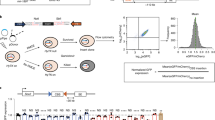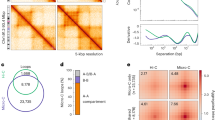Abstract
Gene activation in eukaryotes is regulated by complex mechanisms in which the recruitment and assembly of the transcriptional machinery is directed by gene- and cell-type-specific DNA-binding proteins1. When DNA is packaged into chromatin, the regulation of gene activation requires new classes of chromatin-targeting activity2. In humans, a multisubunit cofactor functions in a chromatin-selective manner to potentiate synergistic gene activation by the transcriptional activators SREBP-1a and Sp1 (ref. 3). Here we show that this activator-recruited cofactor (ARC) interacts directly with several different activators, including SREBP-1a, VP16 and the p65 subunit of NF-κB, and strongly enhances transcription directed by these activators in vitro with chromatin-assembled DNA templates. The ARC complex consists of 16 or more subunits; some of these are novel gene products, whereas others are present in other multisubunit cofactors, such as CRSP4, NAT5 and mammalian Mediator6. Detailed analysis indicates that the ARC complex is probably identical to the nuclear hormone-receptor cofactor DRIP7. Thus, ARC/DRIP is a large composite co-activator that belongs to a family of related cofactors and is targeted by different classes of activator to mediate transcriptional stimulation.
This is a preview of subscription content, access via your institution
Access options
Subscribe to this journal
Receive 51 print issues and online access
$199.00 per year
only $3.90 per issue
Buy this article
- Purchase on Springer Link
- Instant access to full article PDF
Prices may be subject to local taxes which are calculated during checkout




Similar content being viewed by others
References
Sauer, F. & Tjian, R. Mechanisms of transcriptional activation: differences and similarities between yeast, Drosophila, and man. Curr. Opin. Genet. Dev. 7, 176–181 (1997).
Struhl, K. Histone acetylation and transcriptional regulatory mechanisms. Genes Dev. 12, 599–606 ( 1998).
Näär, A. M. et al. Chromatin, TAFs, and a novel multiprotein coactivator are required for synergistic activation by Sp1 and SREBP-1a in vitro. Genes Dev. 12, 3020–3031 (1998).
Ryu, S., Zhou, S., Ladurner, A. G. & Tijan, R. The transcriptional cofactor complex CRSP is required for activity of the enhancer-binding protein Sp1. Nature 397, 446–450 (1999).
Sun, X.et al. NAT, a human complex containing Srb polypeptides that functions as a negative regulator of activated transcription. Mol. Cell 2, 213–222 (1998).
Jiang, Y. W.et al. Mammalian mediator of transcriptional regulation and its possible role as an end-point of signal transduction pathways. Proc. Natl Acad. Sci. USA 95, 8538–8543 (1998).
Rachez, C.et al. Ligand-dependent transcription activation by nuclear receptors requires the DRIP complex. Nature 398, 824 –828 (1999).
Oliner, J. D., Andresen, J. M., Hansen, S. K., Zhou, S. & Tjian, R. SREBP transcriptional activity is mediated through an interaction with the CREB-binding protein. Genes Dev. 10, 2903–2911 (1996).
Perkins, N. D.et al. Regulation of NF-kappaB by cyclin-dependent kinases associated with the p300 coactivator. Science 275, 523–527 (1997).
Gerritsen, M. E.et al . CREB-binding protein/p300 are transcriptional coactivators of p65. Proc. Natl Acad. Sci. USA 94, 2927 –2932 (1997).
Regier, J. L., Shen, F. & Triezenberg, S. J. Pattern of aromatic and hydrophobic amino acids critical for one of two subdomains of the VP16 transcriptional activator. Proc. Natl Acad. Sci. USA 90, 883– 887 (1993).
Zhu, Y., Qi, C., Jain, S., Rao, M. S. & Reddy, J. K. Isolation and characterization of PBP, a protein that interacts with peroxisome proliferator-activated receptor. J. Biol. Chem. 272, 25500–25506 ( 1997).
Drane, P., Barel, M., Balbo, M. & Frade, R. Identification of RB18A, a 205 kDa new p53 regulatory protein which shares antigenic and functional properties with p53. Oncogene 15, 3013–3024 (1997).
Lee, J. W., Choi, H. S., Gyuris, J., Brent, R. & Moore, D. D. Two classes of proteins dependent on either the presence or absence of thyroid hormone for interaction with the thyroid hormone receptor. Mol. Endocrinol. 9, 243– 254 (1995).
Yuan, C. X., Ito, M., Fondell, J. D., Fu, Z. Y. & Roeder, R. G. The TRAP220 component of a thyroid hormone receptor-associated protein (TRAP) coactivator complex interacts directly with nuclear receptors in a ligand-dependent fashion. Proc. Natl Acad. Sci. USA 95, 7939–7944 (1998).
Rachez, C.et al. Anovel protein complex that interacts with the vitamin D3 receptor in a ligand-dependent manner and enhances VDR transactivation in a cell-free system. Genes Dev. 12, 1787– 1800 (1998).
Fondell, J. D., Brunel, F., Hisatake, K. & Roeder, R. G. Unliganded thyroid hormone receptor alpha can target TATA-binding protein for transcriptional repression. Mol. Cell Biol. 16, 281– 287 (1996).
Myers, L. C.et al. The Med proteins of yeast and their function through the RNA polymerase II carboxy-terminal domain. Genes Dev. 12 , 45–54 (1998).
Kim, Y. J., Bjorklund, S., Li, Y., Sayre, M. H. & Kornberg, R. D. Amultiprotein mediator of transcriptional activation and its interaction with the C-terminal repeat domain of RNA polymerase II. Cell 77, 599–608 (1994).
Grant, P. A.et al. Asubset of TAF(II)s are integral components of the SAGA complex required for nucleosome acetylation and transcriptional stimulation. Cell 94, 45–53 ( 1998).
Ogryzko, V. V.et al . Histone-like TAFs within the PCAF histone acetylase complex. Cell 94, 35–44 (1998).
Gu, W.et al. Anovel human SRB/MED-containing cofactor complex, SMCC, involved in transcription regulation. Mol. Cell 3, 97– 108 (1999).
Dignam, J. D., Lebovitz, R. M. & Roeder, R. G. Accurate transcription initiation by RNA polymerase II in a soluble extract from isolated mammalian nuclei. Nucleic Acids Res. 11, 1475–1489 (1983).
Kamakaka, R. T., Bulger, M. & Kadonaga, J. T. Potentiation of RNA polymerase II transcription by Gal4-VP16 during but not after DNA replication and chromatin assembly. Genes Dev. 7, 1779–1795 (1993).
Lillie, J. W. & Green, M. R. Transcription activation by the adenovirus E1a protein. Nature 338, 39– 44 (1989).
Acknowledgements
We thank P. Kaufman, J. Kadonaga, B. Lemon, J. Zwicker, S. Ryu, A. Ladurner and M. Rabenstein for critical reading of the manuscript; R. Burgess for providing the 8WG16 cell line; Z. Cao for the NF-κB p65 subunit; B. Lemon for the purified core Pol II and DRIPs; W. Dynan for the plasmid encoding GST–CTD; S. Triezenberg for plasmids containing VP16 point mutations; R. Kornberg for the antibody against human Med7; S. Ryu for antibodies against CRSP subunits; and A. Ladurner for helping with sequence comparisons. This work was funded by grants from the NIH and HHMI.
Author information
Authors and Affiliations
Supplementary information
Rights and permissions
About this article
Cite this article
Näär, A., Beaurang, P., Zhou, S. et al. Composite co-activator ARC mediates chromatin-directed transcriptional activation. Nature 398, 828–832 (1999). https://doi.org/10.1038/19789
Received:
Accepted:
Issue Date:
DOI: https://doi.org/10.1038/19789
This article is cited by
-
The Mediator complex as a master regulator of transcription by RNA polymerase II
Nature Reviews Molecular Cell Biology (2022)
-
Molecular mimicry of NF-κB by vaccinia virus protein enables selective inhibition of antiviral responses
Nature Microbiology (2021)
-
Mediator complex interaction partners organize the transcriptional network that defines neural stem cells
Nature Communications (2019)
-
SREBP1-dependent de novo fatty acid synthesis gene expression is elevated in malignant melanoma and represents a cellular survival trait
Scientific Reports (2019)
-
Tyr99 phosphorylation determines the regulatory milieu of tumor suppressor p73
Oncogene (2016)
Comments
By submitting a comment you agree to abide by our Terms and Community Guidelines. If you find something abusive or that does not comply with our terms or guidelines please flag it as inappropriate.



